2011 NISSAN CUBE height adjustment
[x] Cancel search: height adjustmentPage 21 of 345
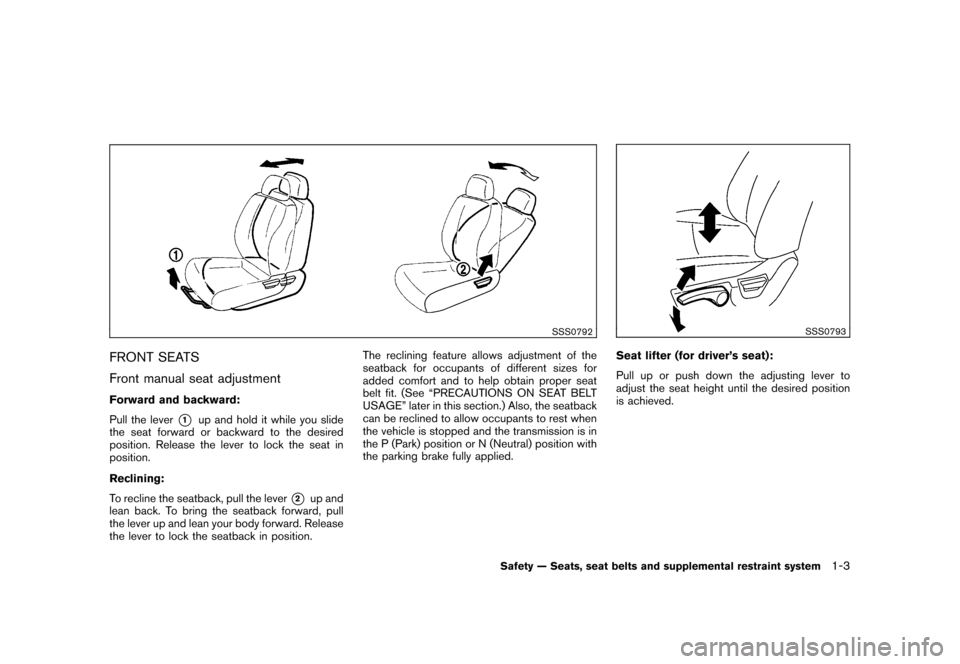
Black plate (17,1)
Model "Z12-D" EDITED: 2010/ 9/ 27
SSS0792
FRONT SEATS
Front manual seat adjustmentForward and backward:
Pull the lever
*1
up and hold it while you slide
the seat forward or backward to the desired
position. Release the lever to lock the seat in
position.
Reclining:
To recline the seatback, pull the lever
*2
up and
lean back. To bring the seatback forward, pull
the lever up and lean your body forward. Release
the lever to lock the seatback in position. The reclining feature allows adjustment of the
seatback for occupants of different sizes for
added comfort and to help obtain proper seat
belt fit. (See “PRECAUTIONS ON SEAT BELT
USAGE” later in this section.) Also, the seatback
can be reclined to allow occupants to rest when
the vehicle is stopped and the transmission is in
the P (Park) position or N (Neutral) position with
the parking brake fully applied.
SSS0793
Seat lifter (for driver’s seat):
Pull up or push down the adjusting lever to
adjust the seat height until the desired position
is achieved.
Safety — Seats, seat belts and supplemental restraint system
1-3
Page 35 of 345
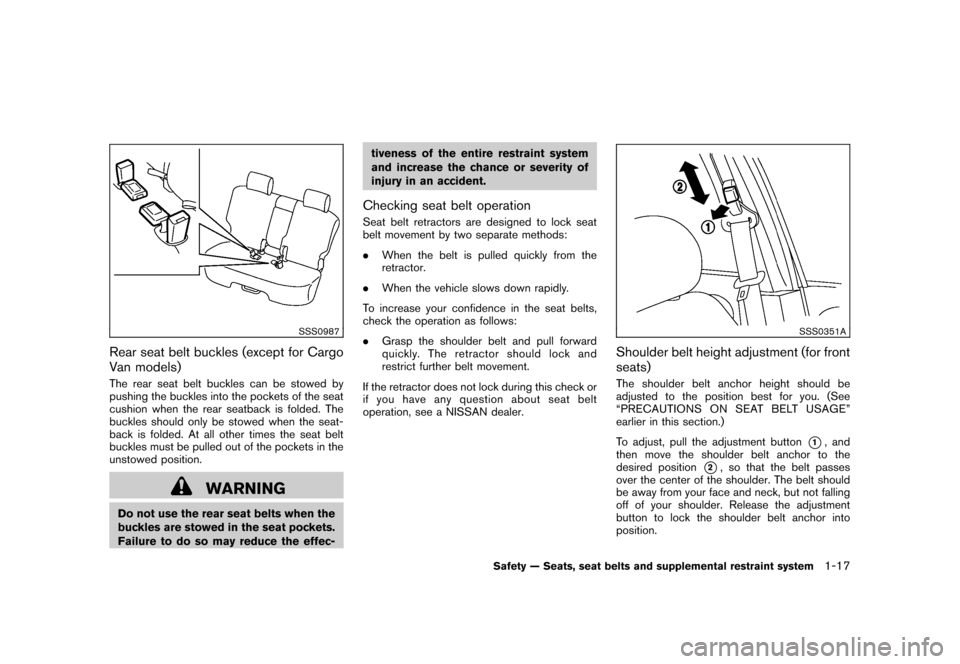
Black plate (31,1)
Model "Z12-D" EDITED: 2010/ 9/ 27
SSS0987
Rear seat belt buckles (except for Cargo
Van models)The rear seat belt buckles can be stowed by
pushing the buckles into the pockets of the seat
cushion when the rear seatback is folded. The
buckles should only be stowed when the seat-
back is folded. At all other times the seat belt
buckles must be pulled out of the pockets in the
unstowed position.
WARNING
Do not use the rear seat belts when the
buckles are stowed in the seat pockets.
Failure to do so may reduce the effec-tiveness of the entire restraint system
and increase the chance or severity of
injury in an accident.
Checking seat belt operationSeat belt retractors are designed to lock seat
belt movement by two separate methods:
.
When the belt is pulled quickly from the
retractor.
. When the vehicle slows down rapidly.
To increase your confidence in the seat belts,
check the operation as follows:
. Grasp the shoulder belt and pull forward
quickly. The retractor should lock and
restrict further belt movement.
If the retractor does not lock during this check or
if you have any question about seat belt
operation, see a NISSAN dealer.
SSS0351A
Shoulder belt height adjustment (for front
seats)The shoulder belt anchor height should be
adjusted to the position best for you. (See
“PRECAUTIONS ON SEAT BELT USAGE”
earlier in this section.)
To adjust, pull the adjustment button
*1, and
then move the shoulder belt anchor to the
desired position
*2, so that the belt passes
over the center of the shoulder. The belt should
be away from your face and neck, but not falling
off of your shoulder. Release the adjustment
button to lock the shoulder belt anchor into
position.
Safety — Seats, seat belts and supplemental restraint system
1-17
Page 36 of 345
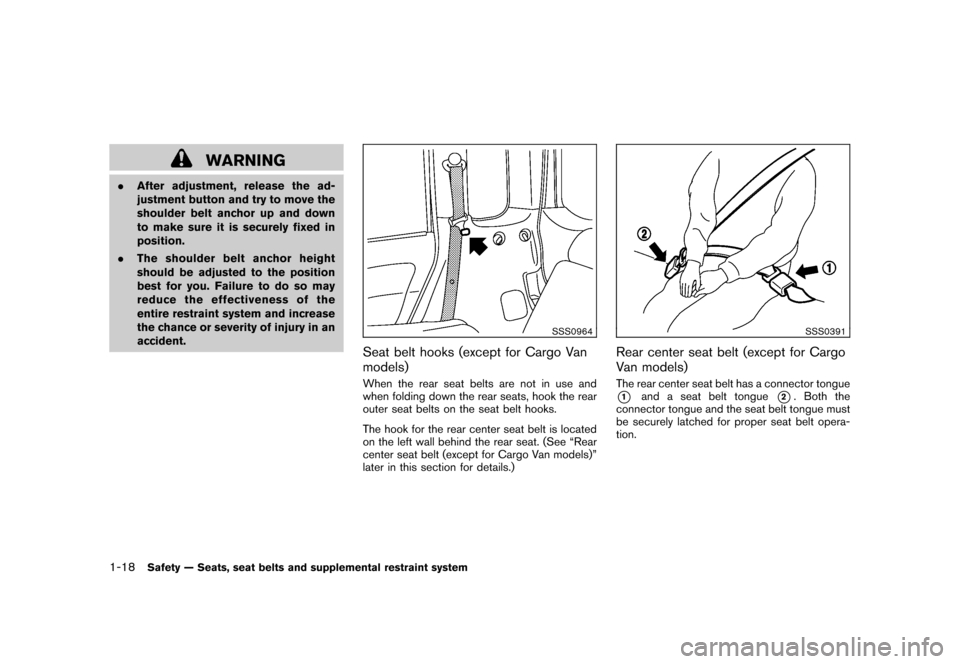
Black plate (32,1)
Model "Z12-D" EDITED: 2010/ 9/ 27
WARNING
.After adjustment, release the ad-
justment button and try to move the
shoulder belt anchor up and down
to make sure it is securely fixed in
position.
. The shoulder belt anchor height
should be adjusted to the position
best for you. Failure to do so may
reduce the effectiveness of the
entire restraint system and increase
the chance or severity of injury in an
accident.
SSS0964
Seat belt hooks (except for Cargo Van
models)When the rear seat belts are not in use and
when folding down the rear seats, hook the rear
outer seat belts on the seat belt hooks.
The hook for the rear center seat belt is located
on the left wall behind the rear seat. (See “Rear
center seat belt (except for Cargo Van models)”
later in this section for details.)
SSS0391
Rear center seat belt (except for Cargo
Van models)The rear center seat belt has a connector tongue*1
and a seat belt tongue
*2. Both the
connector tongue and the seat belt tongue must
be securely latched for proper seat belt opera-
tion.
1-18
Safety — Seats, seat belts and supplemental restraint system
Page 42 of 345
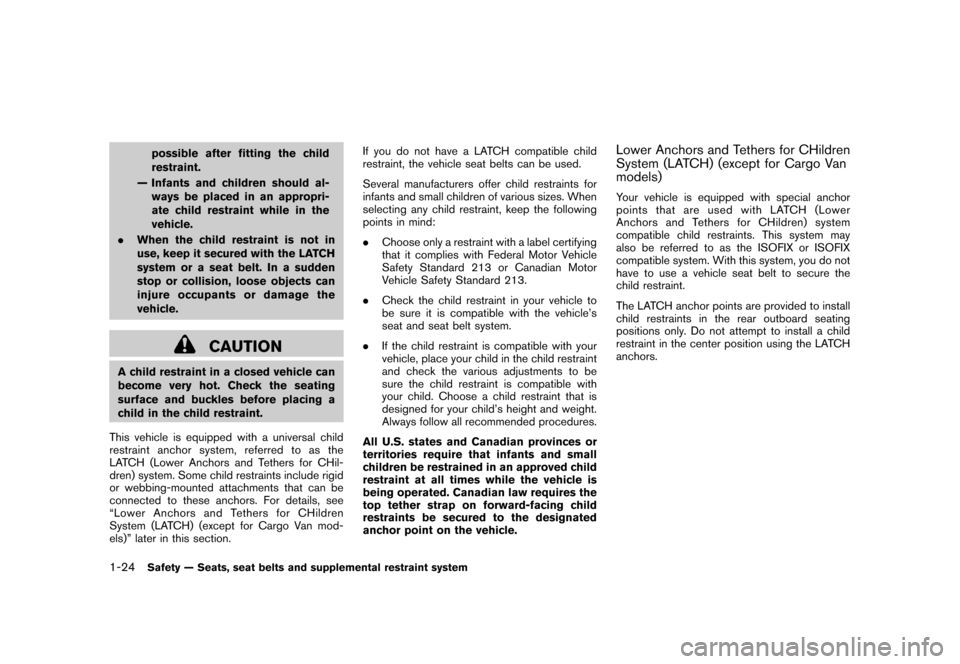
Black plate (38,1)
Model "Z12-D" EDITED: 2010/ 9/ 27
possible after fitting the child
restraint.
— Infants and children should al- ways be placed in an appropri-
ate child restraint while in the
vehicle.
. When the child restraint is not in
use, keep it secured with the LATCH
system or a seat belt. In a sudden
stop or collision, loose objects can
injure occupants or damage the
vehicle.
CAUTION
A child restraint in a closed vehicle can
become very hot. Check the seating
surface and buckles before placing a
child in the child restraint.
This vehicle is equipped with a universal child
restraint anchor system, referred to as the
LATCH (Lower Anchors and Tethers for CHil-
dren) system. Some child restraints include rigid
or webbing-mounted attachments that can be
connected to these anchors. For details, see
“Lower Anchors and Tethers for CHildren
System (LATCH) (except for Cargo Van mod-
els)” later in this section. If you do not have a LATCH compatible child
restraint, the vehicle seat belts can be used.
Several manufacturers offer child restraints for
infants and small children of various sizes. When
selecting any child restraint, keep the following
points in mind:
.
Choose only a restraint with a label certifying
that it complies with Federal Motor Vehicle
Safety Standard 213 or Canadian Motor
Vehicle Safety Standard 213.
. Check the child restraint in your vehicle to
be sure it is compatible with the vehicle’s
seat and seat belt system.
. If the child restraint is compatible with your
vehicle, place your child in the child restraint
and check the various adjustments to be
sure the child restraint is compatible with
your child. Choose a child restraint that is
designed for your child’s height and weight.
Always follow all recommended procedures.
All U.S. states and Canadian provinces or
territories require that infants and small
children be restrained in an approved child
restraint at all times while the vehicle is
being operated. Canadian law requires the
top tether strap on forward-facing child
restraints be secured to the designated
anchor point on the vehicle.
Lower Anchors and Tethers for CHildren
System (LATCH) (except for Cargo Van
models)Your vehicle is equipped with special anchor
points that are used with LATCH (Lower
Anchors and Tethers for CHildren) system
compatible child restraints. This system may
also be referred to as the ISOFIX or ISOFIX
compatible system. With this system, you do not
have to use a vehicle seat belt to secure the
child restraint.
The LATCH anchor points are provided to install
child restraints in the rear outboard seating
positions only. Do not attempt to install a child
restraint in the center position using the LATCH
anchors.
1-24
Safety — Seats, seat belts and supplemental restraint system
Page 341 of 345
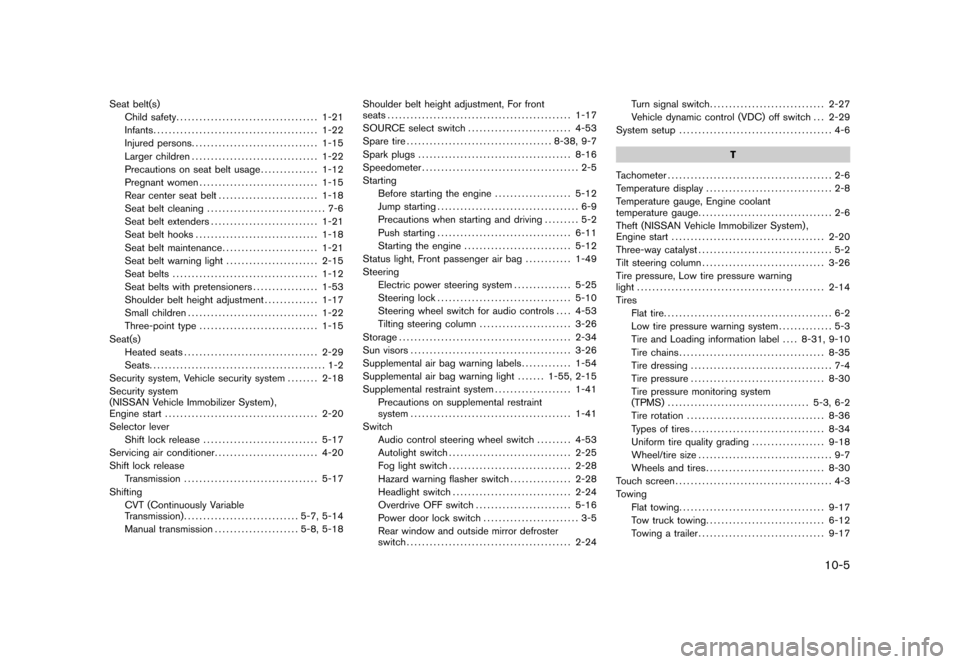
Black plate (5,1)
Seat belt(s)Child safety ..................................... 1-21
Infants ........................................... 1-22
Injured persons ................................. 1-15
Larger children ................................. 1-22
Precautions on seat belt usage ............... 1-12
Pregnant women ............................... 1-15
Rear center seat belt .......................... 1-18
Seat belt cleaning ............................... 7-6
Seat belt extenders ............................ 1-21
Seat belt hooks ................................ 1-18
Seat belt maintenance ......................... 1-21
Seat belt warning light ........................ 2-15
Seat belts ...................................... 1-12
Seat belts with pretensioners ................. 1-53
Shoulder belt height adjustment .............. 1-17
Small children .................................. 1-22
Three-point type ............................... 1-15
Seat(s) Heated seats ................................... 2-29
Seats .............................................. 1-2
Security system, Vehicle security system ........ 2-18
Security system
(NISSAN Vehicle Immobilizer System) ,
Engine start ........................................ 2-20
Selector lever Shift lock release .............................. 5-17
Servicing air conditioner ........................... 4-20
Shift lock release Transmission ................................... 5-17
Shifting CVT (Continuously Variable
Transmission) .............................. 5-7, 5-14
Manual transmission ...................... 5-8, 5-18 Shoulder belt height adjustment, For front
seats
................................................ 1-17
SOURCE select switch ........................... 4-53
Spare tire ...................................... 8-38, 9-7
Spark plugs ........................................ 8-16
Speedometer ......................................... 2-5
Starting Before starting the engine .................... 5-12
Jump starting ..................................... 6-9
Precautions when starting and driving ......... 5-2
Push starting ................................... 6-11
Starting the engine ............................ 5-12
Status light, Front passenger air bag ............ 1-49
Steering Electric power steering system ............... 5-25
Steering lock ................................... 5-10
Steering wheel switch for audio controls .... 4-53
Tilting steering column ........................ 3-26
Storage ............................................. 2-34
Sun visors .......................................... 3-26
Supplemental air bag warning labels ............. 1-54
Supplemental air bag warning light ....... 1-55, 2-15
Supplemental restraint system .................... 1-41
Precautions on supplemental restraint
system .......................................... 1-41
Switch Audio control steering wheel switch ......... 4-53
Autolight switch ................................ 2-25
Fog light switch ................................ 2-28
Hazard warning flasher switch ................ 2-28
Headlight switch ............................... 2-24
Overdrive OFF switch ......................... 5-16
Power door lock switch ......................... 3-5
Rear window and outside mirror defroster
switch ........................................... 2-24 Turn signal switch
.............................. 2-27
Vehicle dynamic control (VDC) off switch . . . 2-29
System setup ........................................ 4-6
T
Tachometer ........................................... 2-6
Temperature display ................................. 2-8
Temperature gauge, Engine coolant
temperature gauge ................................... 2-6
Theft (NISSAN Vehicle Immobilizer System) ,
Engine start ........................................ 2-20
Three-way catalyst ................................... 5-2
Tilt steering column ................................ 3-26
Tire pressure, Low tire pressure warning
light ................................................. 2-14
Tires Flat tire ............................................ 6-2
Low tire pressure warning system .............. 5-3
Tire and Loading information label .... 8-31, 9-10
Tire chains ...................................... 8-35
Tire dressing ..................................... 7-4
Tire pressure ................................... 8-30
Tire pressure monitoring system
(TPMS) ..................................... 5-3, 6-2
Tire rotation .................................... 8-36
Types of tires ................................... 8-34
Uniform tire quality grading ................... 9-18
Wheel/tire size ................................... 9-7
Wheels and tires ............................... 8-30
Touch screen ......................................... 4-3
Towing Flat towing ...................................... 9-17
Tow truck towing ............................... 6-12
Towing a trailer ................................. 9-17
10-5
Model "Z12-D" EDITED: 2010/ 9/ 27